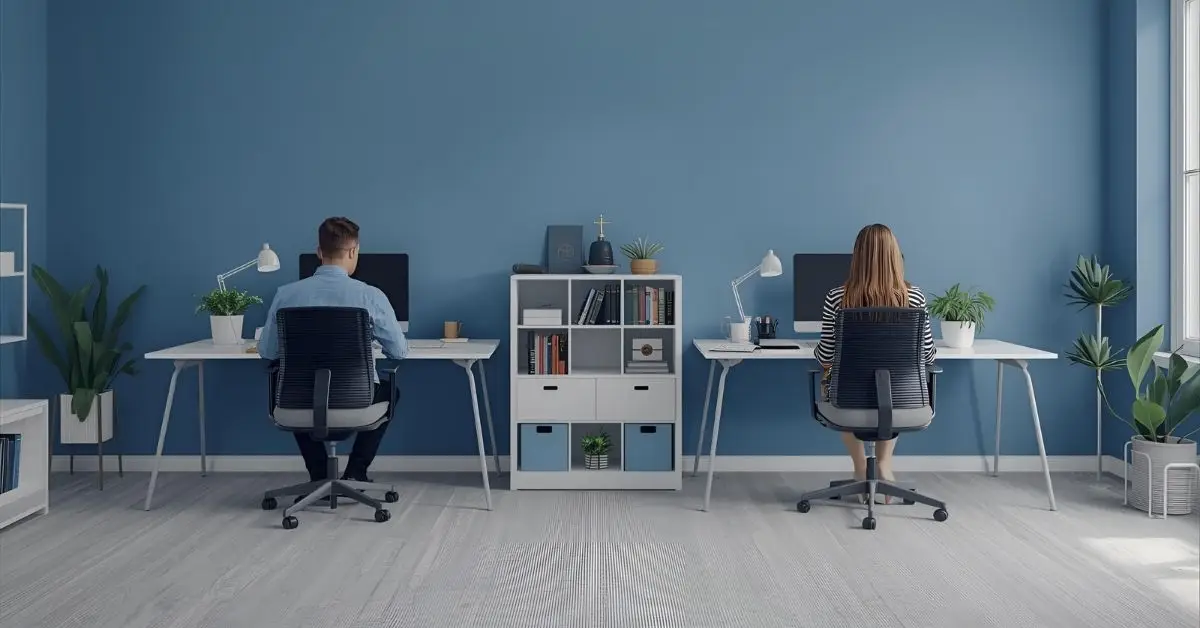
10 Best Shared Home Office Ideas for Couples Working from Home
Are you and your partner looking to share the same home office? Just imagine that you're on an important video call and your partner starts loudly typing away right behind you. Or maybe you both reach for the good chair at the same time every morning. I've been there and gone through the same struggle.
The good news is you don't need a mansion to pull this off. Some really simple shared home office ideas can make all the difference. I learned a few tricks along the way that actually work, and I'm excited to share them with you.
Key Takeaways
- Find 10 practical shared home office ideas that work for couples in any space.
- Understand and avoid the common mistakes people make when setting up their shared office.
1. Side-by-Side Desks with Personal Zones
Simply put two desks right next to each other, but give each person their own little territory. I'm talking about separate desk lamps, matching chairs, your own storage drawers, and maybe even different colored desk accessories. So you know what's yours.

The key is making sure each desk feels like it belongs to one person. My partner and I tried this, and it was amazing how much less we argued about whose stuff was whose. Plus, you can still chat easily when you want to. But you each have your own workspace to focus on.
2. Back-to-Back Layout for Maximum Focus
The back-to-back is an excellent arrangement for couples who often require privacy or silence. Two workstations are set back-to-back, which gives a person their own view and fewer visual distractions. This setup is especially useful in a long room or an area where you can position the office desks in the center.

Place a shared shelving unit or low cabinet between the desks to create a low-key dividing presence. This will separate the two working environments while allowing easy access to shared supplies. This should suit somebody who is making frequent calls or really concentrating with no disturbances.
3. L-Shaped Corner Arrangement
Have you got an L-shaped corner in your room that's basically collecting dust? This is your chance to make it useful. Just put two desks together in the right angle where the walls meet, and boom that you've got your own little work setup.
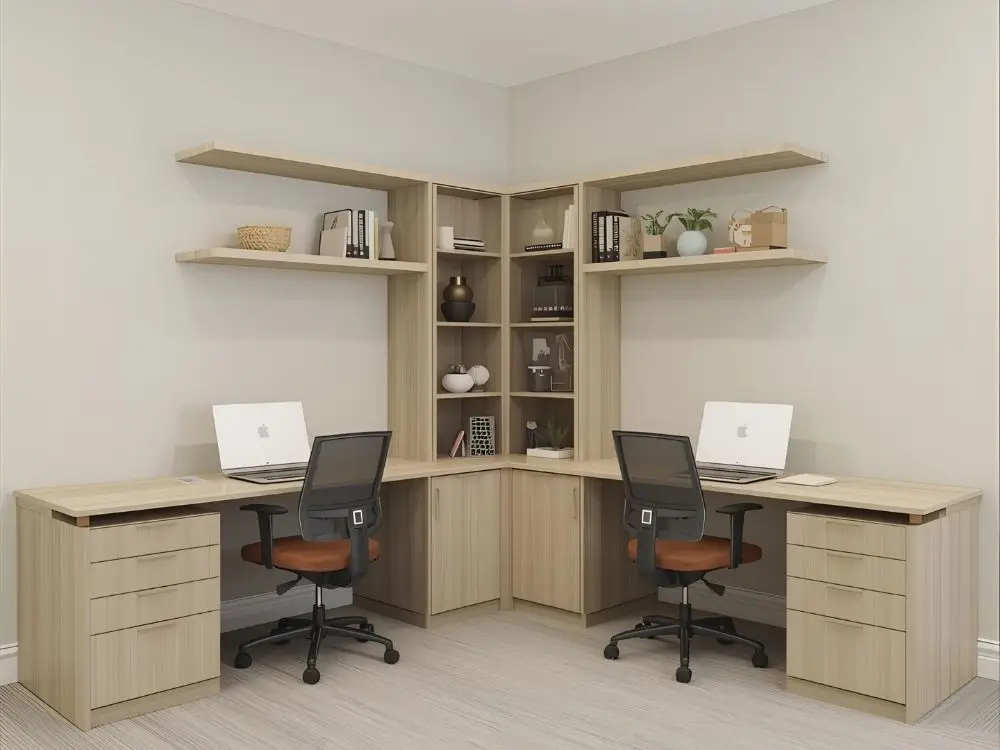
The cool thing is you both get your own space, but you're still close enough to ask "hey, have you seen my stapler?" without shouting across the room. Throw up some shelves above your desks if you can, where you'll need somewhere to put all your stuff. It doesn't matter whether your room is huge or tiny. This just works perfectly.
4. One Long Desk with Two Work Zones
A single long desk can provide two separate workspaces with a few additional items. You can establish and define each personal area with a small partition, desk mats, and proper organizers. This approach is clean and inexpensive because you don't have to purchase a lot of furniture.
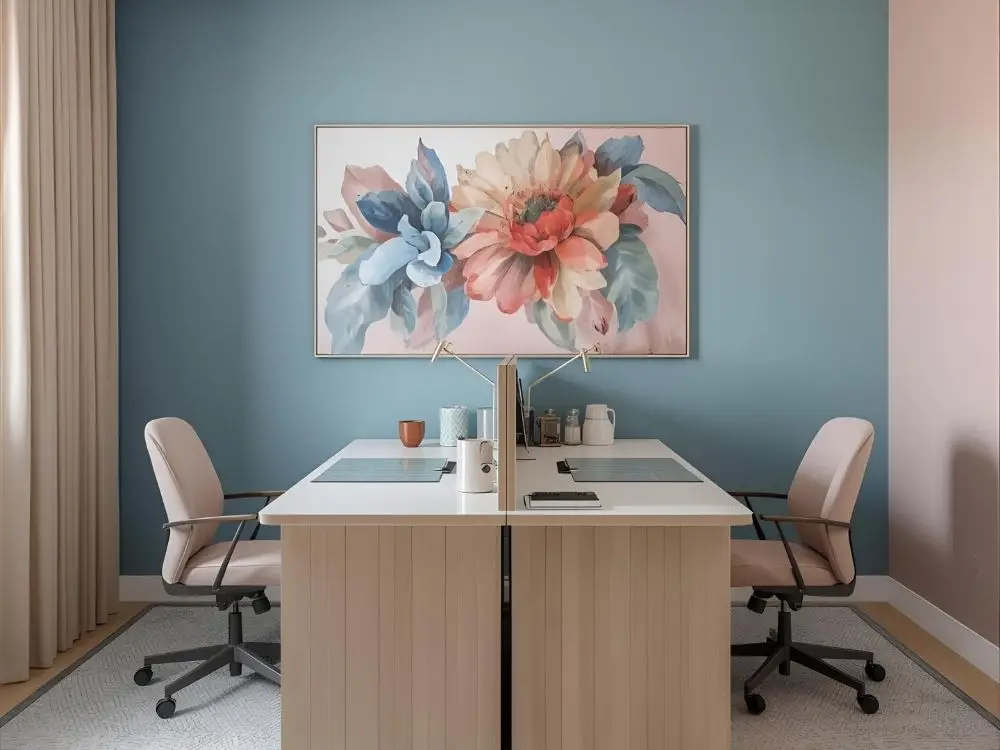
Use a solid surface that comfortably accommodates two chairs and has sufficient legroom. Adequate light on each side will help ensure there are no shadows, so both people can work. This option is ideal for couples who want a minimalist design with their own personal areas.
5. Built-In Desk Wall
A built-in desk wall gives the room a clean, professional appearance. Imagine a long desk that runs along an entire wall like a built-in counter, but for work stuff. You can actually do this pretty easily with a long piece of wood and some brackets.
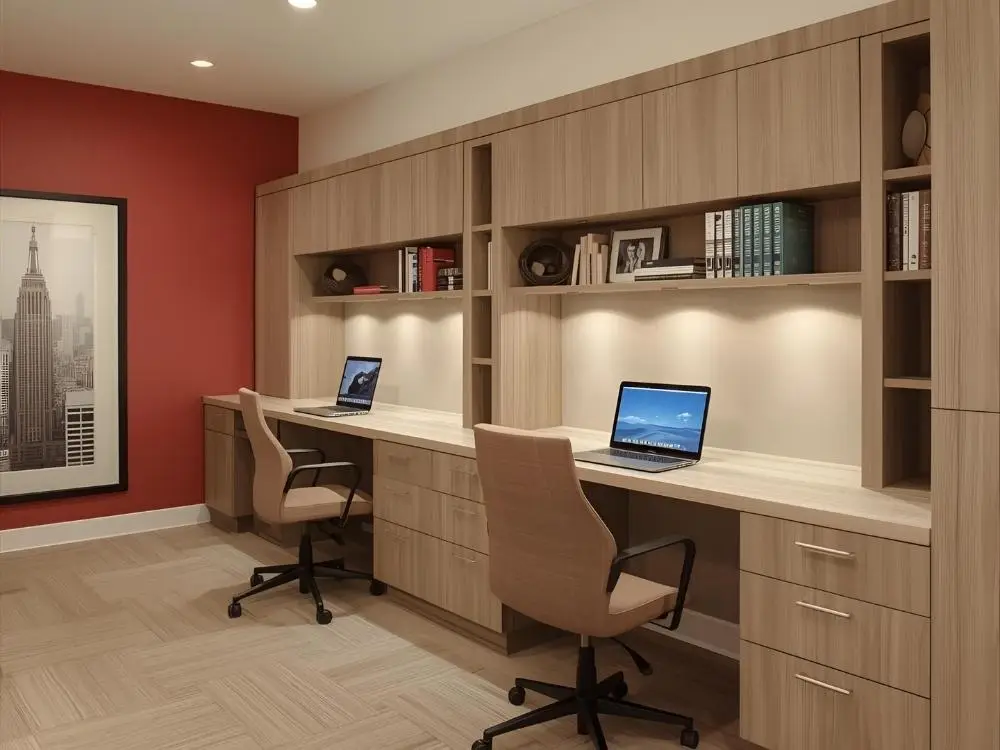
My neighbor did this in her spare bedroom, and it looks amazing. Both she and her husband have plenty of room to spread out, and there's still space left over for a printer or whatever else they need. The best part is no fighting over desk space because there is tons of it. Just make sure you both agree on chair height before you install anything. Also, check this guide on wall decor ideas to make your office walls stunning.
6. Floating Desks to Save Floor Space
If your room feels cramped with two regular desks, floating desks are a total lifesaver. They're basically shelves that stick out from the wall. No bulky legs taking up precious floor space underneath. You may feel skeptical at first because you may think they can be wobbly. But these things are surprisingly sturdy when you mount them right.

You can put two floating desks on the same wall at different/same heights, or even on opposite walls. The room instantly feels bigger because you can actually see the floor. Plus, you can slide storage boxes or a small filing cabinet underneath. Just don't go cheap on the wall brackets. It's ideal for couples living in apartments or shared spaces where every square foot matters.
7. Dual-Height or Adjustable Workstations
This is something most couples don't consider. You're likely a different height than your partner, right? If one of you is taller than the other, then simply getting a desk to the right height can become an even more difficult, ongoing issue that drives everyone mad. Adjustable desks and chairs that can move up and down change everything.

You can find decent adjustable desks and chairs online, or even those desktop converters that sit on top of regular desks. Now you can both work comfortably without anyone hunching over or feeling like they're sitting at a kids' table. Your back will thank you, and you'll stop arguing about the wrong desk height.
8. Coordinated Storage and Organization
A messy shared workspace just makes everything harder. When you both work in the same room, you need storage that makes sense for everyone. Nobody wants to spend half their day looking for stuff.
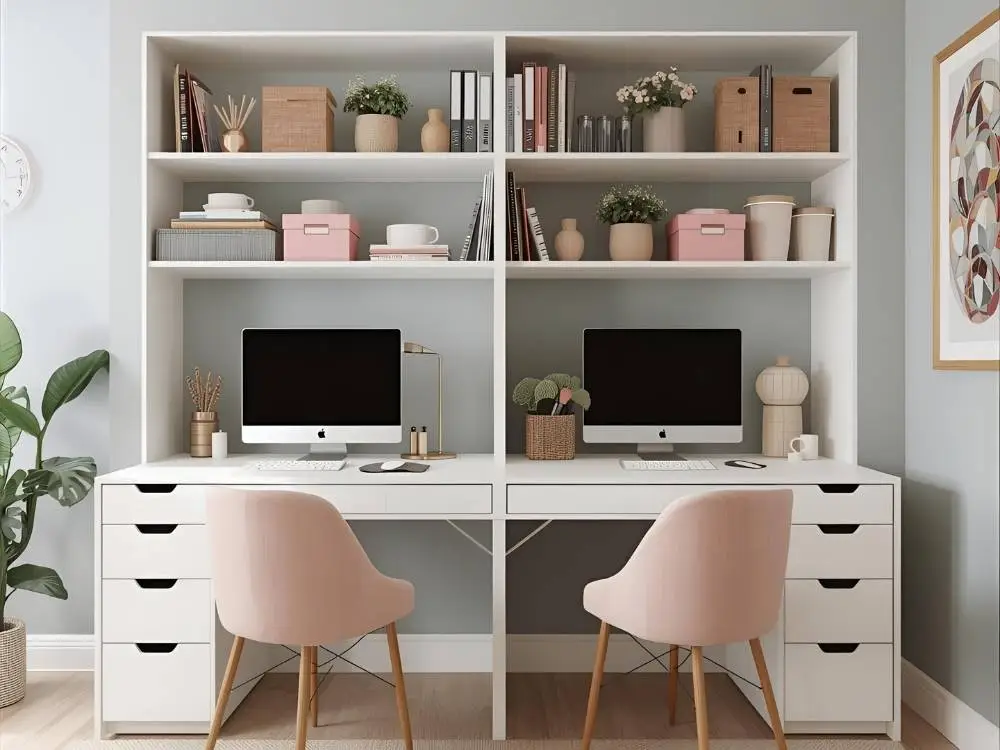
Get some matching containers or desk organizers that look good together. You don't need everything to be exactly the same. However, the whole space feels better when things coordinate. When you both know where things belong, there are way fewer struggles finding the necessary stuff. This will save you time and improve your productivity.
9. Harmonized Lighting and Tech Setup
Good lighting and reliable technology are essential for a productive shared office. You can plan your workspace setup for natural lighting. Additionally, facilitate each desk with task lighting to avoid eye strain and reduce shadows. Make sure to have a strong Wi-Fi and install multiple charging stations so both partners can connect devices without hassle.
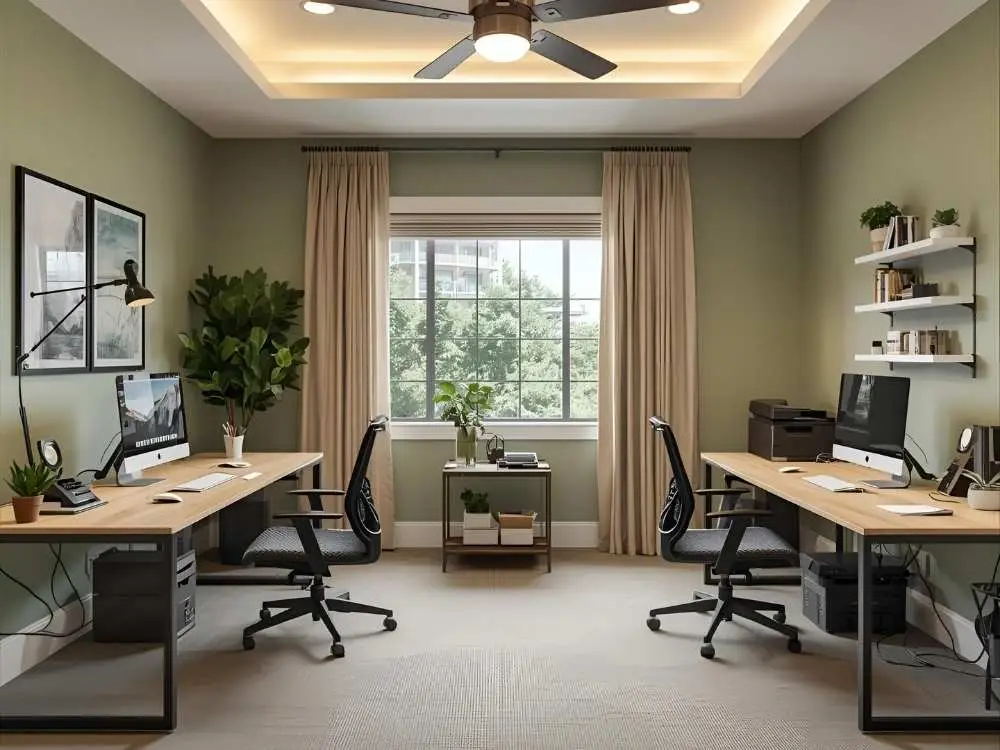
Aim to utilize wireless accessories as much as possible. This helps reduce overall wire clutter and keep the space organized. You may also want to include a shared printer that can be centralized and easy to access. A consistent use of both lighting and technology will assist both of you to function productively.
10. Relaxation or Breakout Nook
Adding a small relaxation space can help you get away from work stress. You can put a comfy chair and a couple of bean bags, which give you a spot to relax during the workday. This is so important to reduce work pressure and improve overall productivity.
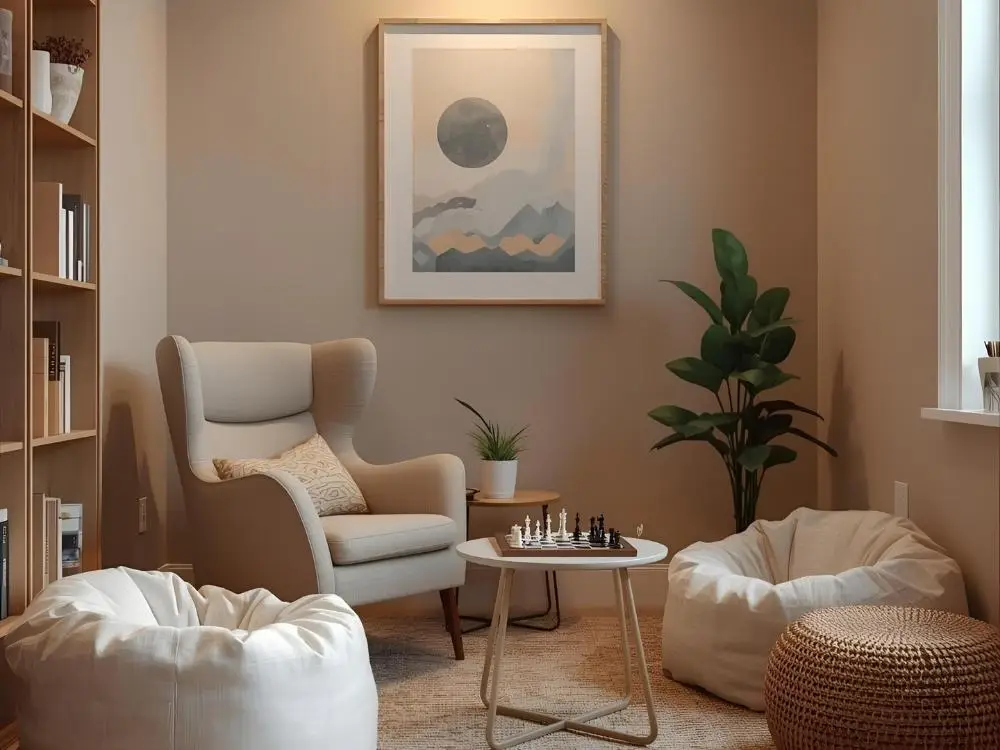
Use a small lamp or soft lighting option. Maybe a small side table or tools for indoor games, or some plants to make it feel cozy. Taking short breaks together or individually can improve focus when you return to work. A breakout/relaxation area can add warmth and balance to a co-working space.
Common Mistakes to Avoid
Let's see some big mistakes couples make when setting up their shared home office that you'll want to skip.
- Not thinking about noise: One person typing loudly or taking calls can drive the other crazy. Plan for some sound control from the start.
- Choosing different chair heights: It's vital to match chair heights when both of you use the same desk area. Mismatched chair heights create constant adjustments and arguments.
- Forgetting about personal space: Even in a shared office, everyone needs their own small area that feels private and organized.
- Skipping the cable management: Two people means twice the charging cables and computer cords. You have to get this organized early or face daily tangles.
- Putting both monitors facing each other: This type of setup may create distractions and make it hard to focus when your partner is always in your line of sight.
Wrapping Up
A shared home office strengthens both co-working and productivity when designed thoughtfully. These ideas help turn any big spare room or little corner into a people place. Discuss what you need, then systematically set the layout and start shaping your style.
FAQs
Q1: How much space do I need for a shared home office?
These are subject to an individual's set of preferences. However, at least 80 square feet per head is good enough to work comfortably on basic desks and chairs.
Q2: What's the best desk arrangement for couples?
An L-shaped arrangement or Back-to-Back Layout can work perfectly. They allow for privacy while keeping you close enough to communicate.
Q3: How do you reduce noise in a shared office?
Soft furnishings can help. Also, acoustic panels or proper coordination for suggested time for quiet gatherings, especially for important calls or intense focus on work, can be helpful.
Q4: Should couples have separate or shared storage?
Both could work. Share the common supplies. Keep things for themselves in separate organizers so that confusion is avoided.
Explore Related Posts
https://smarttoolsai.com/post/home-office-ideas
https://smarttoolsai.com/post/declutter-your-workspace-home-office-organization
.webp)